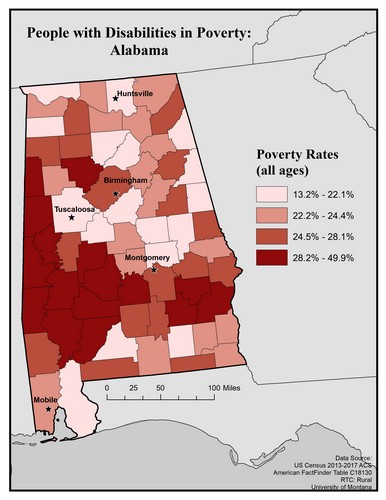Alabama State Profile
The maps on this page explore the American Community Survey 5-year data (Table S1810) on disability by county.
The ACS does not directly measure disability. Instead, it uses a set of disability indicator questions related to difficulty and functional impairment to identify individuals who may experience a disability. If a respondent can answer “yes” to any disability question they are classified as having a disability.
Disability Rates: Alabama
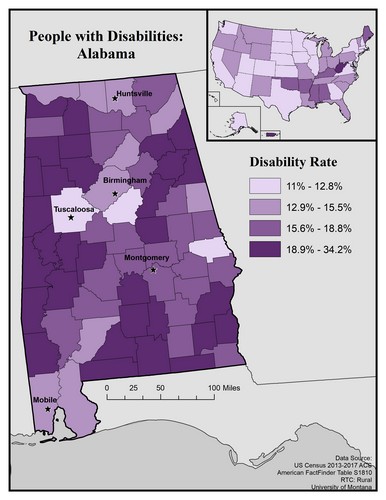 This map of the state of Alabama shows general rates of disability by county. Disability rates are broken into four levels: 11 to 12.8%, 12.9 to 15.5%, 15.6 to 18.8%, and 18.9 to 34.2%.
This map of the state of Alabama shows general rates of disability by county. Disability rates are broken into four levels: 11 to 12.8%, 12.9 to 15.5%, 15.6 to 18.8%, and 18.9 to 34.2%.
Of the 67 counties in Alabama, 31 of them have the highest (18.9 to 34.2%) disability rates. These counties are located along the western border with Mississippi, south of Montgomery, and east of Birmingham.
Rates are lowest (11 to 12.8%) in only three counties: Tuscaloosa, Shelby (near the middle of the state), and Lee (on the eastern border). Rates tend to be higher in rural counties than in urban ones.
In the upper corner there is an inset map of the United States showing how overall general disability rates in Alabama compare to other states. Overall, Alabama has higher rates of disability than most other states. Only West Virginia has a higher overall rate of disability.
Map produced July 2019 based on 2013-2017 American Community Survey data.
- Click on the map for a larger, downloadable version.
- To browse or download the data used to make this map, use our Disability Data Lookup Tool.
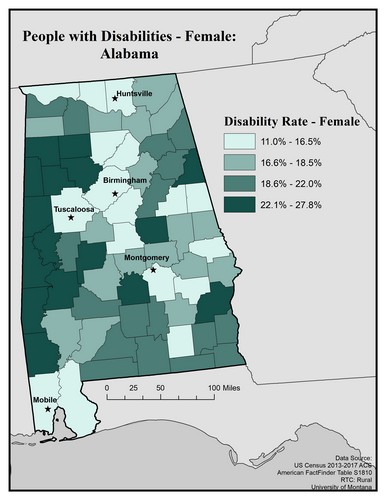 This map of the state of Alabama shows disability rates among females by county. Rates are broken into four categories: 11.0 to 16.5%, 16.6 to 18.5%, 18.6 to 22.0%, and 22.1 to 27.8%.
This map of the state of Alabama shows disability rates among females by county. Rates are broken into four categories: 11.0 to 16.5%, 16.6 to 18.5%, 18.6 to 22.0%, and 22.1 to 27.8%.
Sixteen of the 67 counties in Alabama have the highest rates, of 22.1 to 27.8%. They are mostly along the western border of the state: Marion, Winston, Lamar, Fayette, Walker, Pickens, Greene, Sumter, Choctaw, Marengo, Perry, and Washington. Cleburne, Coosa, Lowndes, and Barbour also have the highest rates. Counties with higher rates of disability among females tend to be more rural.
Seventeen counties have the lowest rates, of 11.0 to 16.5%, and are scattered across the state. These counties are: Lauderdale, Limestone, Madison, Cullman, Blount, Jefferson, Tuscaloosa, Shelby, Chilton, Clay, Randolph, Lee, Montgomery, Bullock, Coffee, Mobile, and Baldwin. These counties tend to be more urban.
Map produced July 2019 based on 2013-2017 American Community Survey data.
- To browse or download the data used to make this map, use our Disability Data Lookup Tool.
- For information on how biological sex is used and defined in the ACS, see “American Community Survey and Puerto Rico Community Survey 2017 Subject Definitions” page 125.
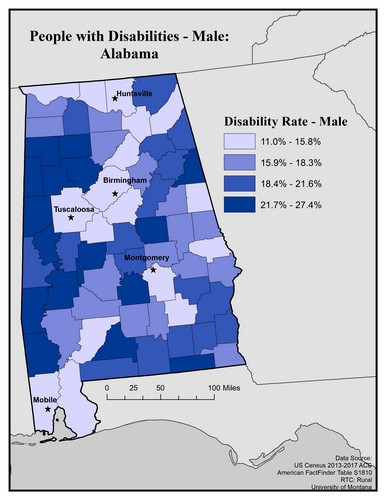 This map of the state of Alabama shows disability rates among males by county. Rates are broken into four categories: 11.0 to 15.8%, 15.9 to 18.3%, 18.4 to 21.6%, and 21.7 to 27.4%.
This map of the state of Alabama shows disability rates among males by county. Rates are broken into four categories: 11.0 to 15.8%, 15.9 to 18.3%, 18.4 to 21.6%, and 21.7 to 27.4%.
Sixteen of the 67 counties in Alabama have the highest rates, of 21.7 to 27.4%. They are: Marion, Winston, Lamar, Fayette, Walker, Pickens, Greene, Perry, Marengo, Choctaw, Washington, Cleburne, Coosa, Lowndes, Conecuh, and Geneva. These counties tend to be more rural.
Seventeen counties have the lowest rates, of 11.0 to 16.5%, and are scattered across the state: Lauderdale, Limestone, Madison, Marshall, DeKalb, Blount, Jefferson, Shelby, Bibb, Tuscaloosa, Mobile, Baldwin, Monroe, Montgomery, Pike, Randolph, and Lee. These counties tend to be more urban.
Map produced July 2019 based on 2013-2017 American Community Survey data.
- Click on the map for a larger, downloadable version.
- To browse or download the data used to make this map, use our Disability Data Lookup Tool.
- For information on how biological sex is used and defined in the ACS, see “American Community Survey and Puerto Rico Community Survey 2017 Subject Definitions” page 125.
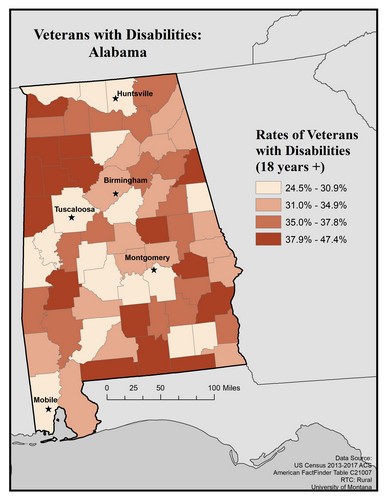 This map of the state of Alabama shows rates of disability among veterans aged 18 and older by county.
This map of the state of Alabama shows rates of disability among veterans aged 18 and older by county.
Rates are broken into four categories: 24.5 to 30.9%, 31.0 to 34.9%, 35.0 to 37.8%, and 37.9 to 47.4%.
Rates are varied across the state.
Of the 67 counties in Alabama, 16 have the highest rate, of 37.9 to 47.4%. Seventeen counties have the second-highest rate of 35.0 to 37.8%, and a second set of 17 counties have the second-lowest rate, of 31.0 to 34.9%. The remaining 17 counties have the lowest rate, of 24.5 to 30.9%.
Map produced July 2019 based on 2013-2017 American Community Survey data.
- Click on the map for a larger, downloadable version.
- To browse or download the data used to make this map, use our Disability Data Lookup Tool.
This map of the state of Alabama shows poverty rates among people with disabilities by county. Poverty rates are broken into four levels: 13.2 to 17.2%, 17.3 to 21.3%, 21.4 to 26%, and 26.1to 49.9%.
Of the 67 counties in Alabama, 27 have the highest (26.1 to 49.9%) poverty rates among people with disabilities, and 28 have the second highest rates (21.4 to 26%). Eight counties have rates of 17.3 to 21.3%.The only three counties with low rates (13.2 to 17.2%) are Baldwin, Elmore, and Shelby, all urban counties.
This map shows that there are high rates of poverty among people with disabilities in most counties in Alabama, both rural and urban. Rates tend to be higher in rural counties than in urban ones.
Map produced July 2019 based on 2013-2017 American Community Survey data.
- Click on the map for a larger, downloadable version.
- To browse or download the data used to make this map, use our Disability Data Lookup Tool.
Employment: Alabama
This map explores American Community Survey (ACS) 5-year data (Table C18120) employment estimates by disability type.
The ACS asks a set of disability indicator questions to determine disability. If a respondent can answer “yes” to any disability question they are classified as having a disability. The data below are for ages 18-64.
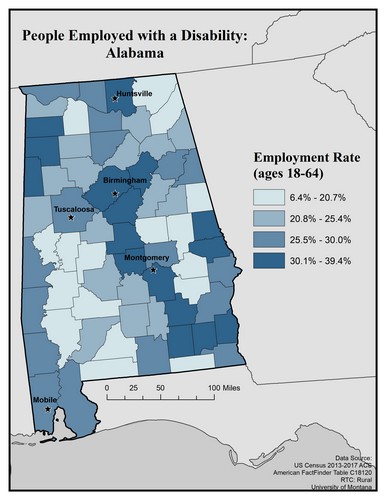 This map of Alabama shows employment rates among people with disabilities. The data includes people ages 18 to 64. Rates are broken into four categories ranging from 6.4% to 39.4%.
This map of Alabama shows employment rates among people with disabilities. The data includes people ages 18 to 64. Rates are broken into four categories ranging from 6.4% to 39.4%.
The highest rates, from 30.1 to 39.4%, are found in mainly urban counties. The sixteen counties with the highest employment rates for people with disabilities are: Madison, Franklin, Marion, Lamar, Jefferson, Blount, Shelby, Chilton, Autauga, Montgomery, Pike, Coffee, Dale, Henry, Chambers, and Lee.
Seventeen counties have the lowest rates of employment for people with disabilities, at 6.4 to 20.7%. These counties are: Jackson, DeKalb, Lawrence, Randolph, Coosa, Tallapoosa, Macon, Bullock, Geneva, Greene, Hale, Perry, Marengo, Wilcox, Clarke, Conecuh, and Escambia.
While some of the counties with higher employment rates are urban, many of the rural counties also have higher rates. However, overall employment rates are higher in urban counties than rural ones.
Map produced July 2019 based on 2013-2017 American Community Survey data.
- Click on the map for a larger, downloadable version.
- To browse or download the data used to make this map, use our Disability Data Lookup Tool.
This map explores American Community Survey (ACS) 5-year data (Table C18120) employment estimates by disability type.
The ACS asks a set of disability indicator questions to determine disability. If a respondent can answer “yes” to any disability question they are classified as having a disability. The data below are for ages 18-64.
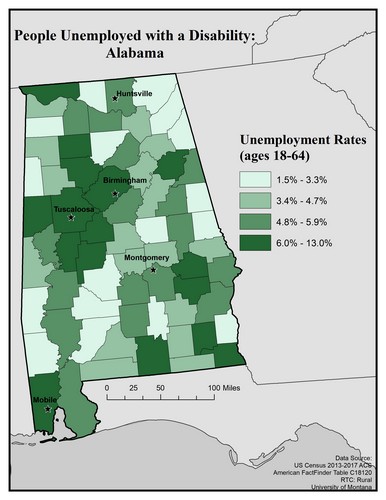 This map of Alabama shows unemployment rates among people with disabilities. The data includes people ages 18 to 64. Rates are broken into four categories ranging from 1.5 to 13.0%.
This map of Alabama shows unemployment rates among people with disabilities. The data includes people ages 18 to 64. Rates are broken into four categories ranging from 1.5 to 13.0%.
The highest rates, from 6.0 to 13.0%, are found in sixteen counties across the state. Most of these counties are urban. They are: Lauderdale, Winston, Walker, Jefferson, Calhoun, Pickens, Tuscaloosa, Bibb, Perry, Hale, Macon, Bullock, Dale, Houston, Covington, and Mobile.
The lowest rates, of 1.5 to 3.3%, are found in seventeen counties across the state. Many, but not all, of these counties are rural. They are: Limestone, Jackson, DeKalb, Cherokee, Franklin, Cullman, Lamar, Coosa, Randolph, Chambers, Dallas, Wilcox, Monroe, Choctaw, Washington, Crenshaw, and Henry.
Note: It is important to consider unemployment rates in addition to out of the labor force rates. This map only shows people with disabilities who are in the labor force.
Map produced July 2019 based on 2013-2017 American Community Survey data.
- Click on the map for a larger, downloadable version.
- To browse or download the data used to make this map, use our Disability Data Lookup Tool.
This map explores American Community Survey (ACS) 5-year data (Table C18120) employment estimates by disability type.
The ACS asks a set of disability indicator questions to determine disability. If a respondent can answer “yes” to any disability question they are classified as having a disability. The data below are for ages 18-64.
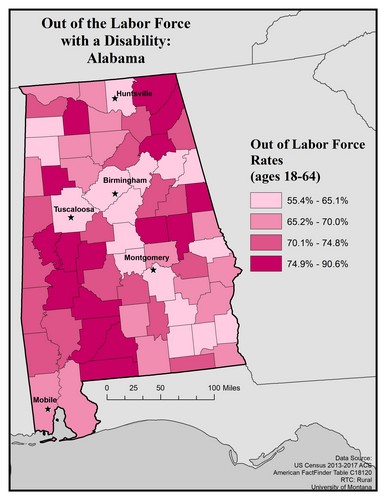 This map of Alabama shows rates of people with disabilities who are out of the labor force, by county. The data includes people ages 18 to 64. Rates are broken into four categories ranging from 55.4 to 90.6%.
This map of Alabama shows rates of people with disabilities who are out of the labor force, by county. The data includes people ages 18 to 64. Rates are broken into four categories ranging from 55.4 to 90.6%.
The highest rates, of 74.9 to 90.6%, are found in sixteen counties across the state. Many of these are rural counties. They include: Lawrence, Jackson, DeKalb, Etowah, Fayette, Randolph, Coosa, Tallapoosa, Greene, Hale, Perry, Marengo, Wilcox, Monroe, Conecuh, and Escambia.
The lowest rates, of 55.4 to 65.1%, are found in seventeen counties across the state. Most of these are urban counties. The counties are: Madison, Franklin, Marion, Tuscaloosa, Jefferson, St. Clair, Calhoun, Cleburne, Shelby, Chilton, Autauga, Montgomery, Lee, Pike, Coffee, Dale, and Henry.
Map produced July 2019 based on 2013-2017 American Community Survey data.
- Click on the map for a larger, downloadable version.
- To browse or download the data used to make this map, use our Disability Data Lookup Tool.
Disability Rates by Functional Limitation: Alabama
This map explores the American Community Survey (ACS) 5-year data (Table S1810) on disability estimates by county.
For vision difficulty the ACS asks if a respondent is blind or has serious difficulty seeing, even when wearing glasses. If they answer “yes” they are classified as having a vision difficulty. This data is for all ages.
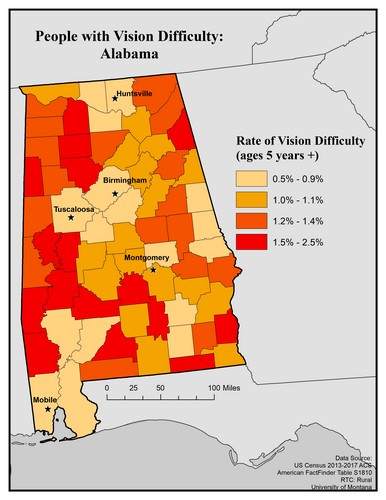 This map of the state of Alabama shows rates of vision difficulty for ages 5 years and older by county. Rates are broken into four categories: 0.5 to 0.9%, 1.0 to 1.1%, 1.2 to 1.4%, and 1.5 to 2.5%.
This map of the state of Alabama shows rates of vision difficulty for ages 5 years and older by county. Rates are broken into four categories: 0.5 to 0.9%, 1.0 to 1.1%, 1.2 to 1.4%, and 1.5 to 2.5%.
Sixteen of the 67 counties in Alabama have the highest rates, of 1.5 to 2.5%. These are: Lawrence, Winston, Walker, Lamar, Greene, Hale, Marengo, Choctaw, Washington, Wilcox, Lowndes, Conecuh, Crenshaw, Geneva, Henry, and Cherokee.
Seventeen counties have the lowest rates, of 0.5 to 0.9%. These are: Limestone, Madison, Morgan, Tuscaloosa, Jefferson, Shelby, Bibb, Randolph, Chambers, Lee, Elmore, Pike, Coffee, Clarke, Monroe, Mobile, and Baldwin.
Map produced July 2019 based on 2013-2017 American Community Survey data.
- Click on the map for a larger, downloadable version.
- To browse or download the data used to make this map, use our Disability Data Lookup Tool.
This map explores the American Community Survey (ACS) 5-year data (Table S1810) on disability estimates by county.
For hearing difficulty the ACS asks if a respondent is deaf or has serious difficulty hearing. If they answer “yes” they are classified as having a hearing difficulty. This data is for all ages.
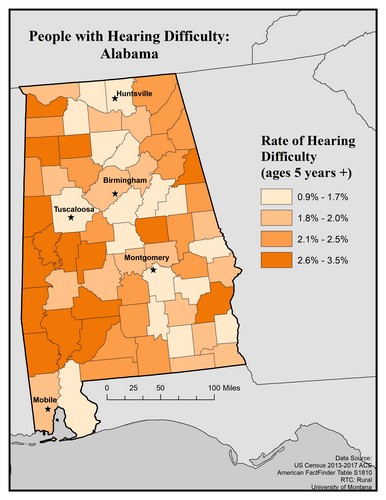 This map of the state of Alabama shows rates of hearing difficulty for ages 5 years and older by county. Rates are broken into four categories: 0.9 to 1.7%, 1.8 to 2.0%, 2.1 to 2.5%, and 2.6 to 3.5%.
This map of the state of Alabama shows rates of hearing difficulty for ages 5 years and older by county. Rates are broken into four categories: 0.9 to 1.7%, 1.8 to 2.0%, 2.1 to 2.5%, and 2.6 to 3.5%.
Sixteen of the 67 counties in Alabama have the highest rates, of 2.6 to 3.5%. These are: Colbert, Marion, Winston, Pickens, Sumter, Greene, Hale, Perry, Choctaw, Washington, Clarke, Wilcox, Monroe, Barbour, Coosa, and Cleburne.
Seventeen counties have the lowest rates, of 0.5 to 0.9%. These are: Limestone, Madison, Lawrence, Cullman, Blount, Tuscaloosa, Shelby, Talladega, Clay, Lee, Chilton, Montgomery, Bullock, Crenshaw, Coffee, Henry, and Baldwin.
Map produced July 2019 based on 2013-2017 American Community Survey data.
- Click on the map for a larger, downloadable version.
- To browse or download the data used to make this map, use our Disability Data Lookup Tool.
This map explores the American Community Survey (ACS) 5-year data (Table S1810) on disability estimates by county.
For cognitive difficulty the ACS asks because of a physical, mental, or emotional problem, does the respondent have difficulty remembering, concentrating, or making decisions. If they answer “yes” they are classified as having a cognitive difficulty. This data is for ages 5 and up.
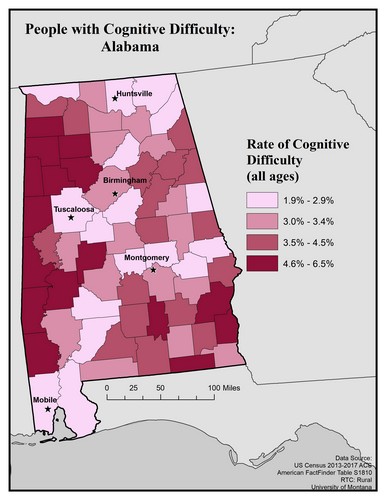 This map of the state of Alabama shows rates of cognitive difficulty for all ages by county. Rates are broken into four categories: 1.9 to 2.9%, 3.0 to 3.4%, 3.5 to 4.5%, and 4.6 to 6.5%.
This map of the state of Alabama shows rates of cognitive difficulty for all ages by county. Rates are broken into four categories: 1.9 to 2.9%, 3.0 to 3.4%, 3.5 to 4.5%, and 4.6 to 6.5%.
Sixteen of the 67 counties in Alabama have the highest rates, of 4.6 to 6.5%. They are mostly along the western border of the state: Franklin, Marion, Winston, Lamar, Fayette, Walker, Pickens, Sumter, Choctaw, Marengo, Perry, and Washington. Crenshaw, Geneva, Barbour, and Henry also have the highest rates. Counties with higher rates of cognitive disability tend to be more rural.
Seventeen counties have the lowest rates, of 0.5 to 0.9%, and are scattered across the state. These counties are: Lauderdale, Madison, Jackson, DeKalb, Blount, Tuscaloosa, Bibb, Shelby, Randolph, Autauga, Elmore, Macon, Lee, Wilcox, Monroe, Baldwin, and Mobile. These counties tend to be more urban.
Map produced July 2019 based on 2013-2017 American Community Survey data.
- Click on the map for a larger, downloadable version.
- To browse or download the data used to make this map, use our Disability Data Lookup Tool.
This map explores the American Community Survey (ACS) 5-year data (Table S1810) on disability estimates by county.
For ambulatory (i.e. mobility) difficulty the ACS asks if a respondent has serious difficulty walking or climbing stairs. If they answer “yes” they are classified as having a mobility difficulty. This data is for ages 5 and up.
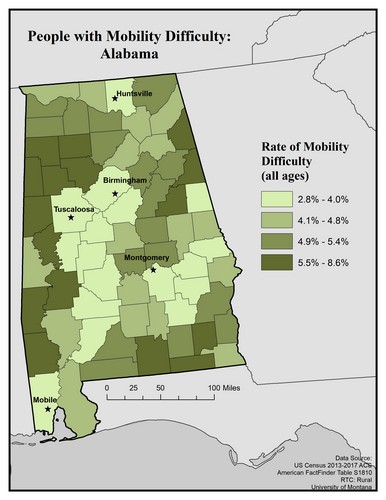 This map of the state of Alabama shows rates of mobility difficulty for all ages by county. Rates are broken into four categories: 2.8 to 4.0%, 4.1 to 4.8%, 4.9 to 5.4%, and 5.5 to 8.6%.
This map of the state of Alabama shows rates of mobility difficulty for all ages by county. Rates are broken into four categories: 2.8 to 4.0%, 4.1 to 4.8%, 4.9 to 5.4%, and 5.5 to 8.6%.
Sixteen of the 67 counties in Alabama have the highest rates, of 5.5 to 8.6%. These counties tend to be along the state borders. They are: Marion, Winston, Lamar, Fayette, Walker, Pickens, Greene, Marengo, Choctaw, Washington, Cherokee, Cleburne, Clay, Covington, Geneva, and Dale. These counties tend to be more rural.
Seventeen counties have the lowest rates, of 2.8 to 4.0%. They are: Madison, Tuscaloosa, Bibb, Shelby, Jefferson, Hale, Perry, Dallas, Wilcox, Monroe, Mobile, Randolph, Lee, Macon, Bullock, Pike, and Montgomery. These counties tend to be more urban.
Map produced July 2019 based on 2013-2017 American Community Survey data.
- Click on the map for a larger, downloadable version.
- To browse or download the data used to make this map, use our Disability Data Lookup Tool.
This map explores the American Community Survey (ACS) 5-year data (Table S1810) on disability estimates by county.
For self-care difficulty the ACS asks if a respondent has difficulty bathing or dressing. If they answer “yes” they are classified as having a self-care difficulty. This data is for ages 5 and up.
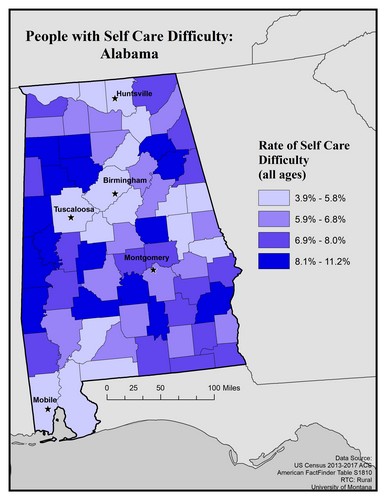 This map of the state of Alabama shows rates of self care difficulty for all ages by county. Rates are broken into four categories: 3.9 to 5.8%, 5.9 to 6.8%, 6.9 to 8.0%, and 8.1 to 11.2%.
This map of the state of Alabama shows rates of self care difficulty for all ages by county. Rates are broken into four categories: 3.9 to 5.8%, 5.9 to 6.8%, 6.9 to 8.0%, and 8.1 to 11.2%.
Sixteen counties have the highest rates of self care difficulty, at 8.1 to 11.2%. These counties are: Marion, Winston, Fayette, Walker, Pickens, Greene, Sumter, Choctaw, Perry, Wilcox, Lowndes, Crenshaw, Coosa, Barbour, Etowah and Calhoun. Seventeen counties have the second-highest rates, of 6.9 to 8.0%. Sixteen counties have rates of 5.9 to 6.8%. Seventeen counties have the lowest rates, of 3.9 to 5.8%. These counties are: Lauderdale, Limestone, Madison, Marshall, Blount, Jefferson, Tuscaloosa, Bibb, Shelby, Clay, Randolph, Tallapoosa, Lee, Monroe, Mobile, Baldwin, and Escambia.
Map produced January 2019 based on 2013-2017 American Community Survey data.
- Click on the map for a larger, downloadable version.
- To browse or download the data used to make this map, use our Disability Data Lookup Tool.
This map explores the American Community Survey (ACS) 5-year data (Table S1810) on disability estimates by county.
For Independent Living difficulty the ACS asks because of a physical, mental, or emotional problem, does the respondent have difficulty doing errands alone such as visiting a doctor’s office or shopping. If they answer “yes” they are classified as having an independent living difficulty. This data is for ages 18 and up.
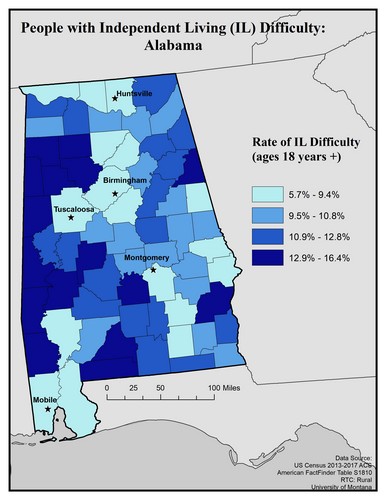 This map of the state of Alabama shows rates of Independent Living (IL) difficulty for people 18 years of age and older by county. Rates are broken into four categories: 5.7 to 9.4%, 9.5 to 10.8%, 10.9 to 12.8%, and 12.9 to 16.4%.
This map of the state of Alabama shows rates of Independent Living (IL) difficulty for people 18 years of age and older by county. Rates are broken into four categories: 5.7 to 9.4%, 9.5 to 10.8%, 10.9 to 12.8%, and 12.9 to 16.4%.
Sixteen counties have the highest rates of IL difficulty, at 12.9 to 16.4% These counties are: Marion, Winston, Lamar, Fayette, Walker, Pickens, Sumter, Choctaw, Perry, Marengo, Washington, Cleburne, Lowndes, Conecuh, Escambia, and Barbour. Most of these are rural counties. Seventeen counties have the second-highest rates, of 10.9 to 12.8% Seventeen counties have rates of 9.5 to 10.8%. Seventeen counties have the lowest rates, of 5.7 to 9.4%. These counties are: Lauderdale, Limestone, Madison, Cullman, Blount, Jefferson, Tuscaloosa, Shelby, Randolph, Lee, Russell, Montgomery, Pike, Coffee, Clarke, Mobile, and Baldwin. Lower rates tend to be found in more urban counties.
Map produced July 2019 based on 2013-2017 American Community Survey data.
- Click on the map for a larger, downloadable version.
- To browse or download the data used to make this map, use our Disability Data Lookup Tool.

